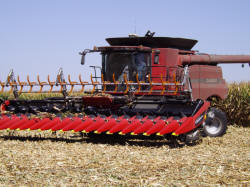 Today, these cabs offer some outstanding features such as
air-spring seats, power steering, air conditioning and heat, GPS
monitoring, and some even feature a second seat for passengers.
Cabs are also designed with better seals and insulation to keep
out the tremendous amount of dust and noise that is generated,
making for a quieter, healthier environment inside the cab. Today, these cabs offer some outstanding features such as
air-spring seats, power steering, air conditioning and heat, GPS
monitoring, and some even feature a second seat for passengers.
Cabs are also designed with better seals and insulation to keep
out the tremendous amount of dust and noise that is generated,
making for a quieter, healthier environment inside the cab.
From outside the farming industry, the regular Joe might not
realize just how important these things can be to the safety and
welfare of the operator.
Since the beginning of the farm tractor, one of the greatest
hazards has been to those who enjoyed the "ride-along." With
early tractors being cabless, many a rider perched on the fender
of the tractor for the ride. As these vehicles crossed the rough
terrain of the farm field, it was possible for the rider to lose
grip and fall off the tractor. These incidents many times
resulted in the rider being run over by the tillage tool being
pulled. The result: loss of limbs, long-term injury and even
death.
The use of a hard-body cab on tractors helped prevent these
types of horror stories, but in those early versions, it was
standing room only for anyone but the driver. Children
especially could be jostled around the cab on rough terrains,
causing less life-threatening injuries such as bumps and
bruises.

Today, many cabs on tractors and combines are equipped with
jump seats for passengers and even include seat belts to help
keep the riders in place. Today, few passengers get run over by
the farm vehicle.
While air seats with specific shock-absorbing features may
seem like a sweet extra, they have proven to be a blessing for
the farmer who sits in the seat from sunup to sundown.
There are many minor injuries that farmers and the safety
industry really don't include in their national statistics, but
industry researchers do.
For the farmer, the early tractors offered a metal seat with
no back. Later, cushioned seats with low backs became a
standard.
The injuries that occurred from these seats were related
primarily to lower back pain and injury caused by vibration from
the tractor or combine. Many farmers develop back issues as well
as problems with the hips and knees as they mature.
Modern seats are designed to absorb the vibration, reduce
impact and support the operator's back. In the long run, this
not only saves muscles and joints, it reduces fatigue and makes
operating the equipment easier for the producer.
Other strides along the way include improvements to the
steering mechanism of the vehicles, reducing back injuries and
muscle strain in the neck and shoulders. Early tractors with no
power steering made the physical labor of the driver more
stressful and, again, more tiring. Today, power steering is a
common feature on the tractor and the combine.
Automated steering through GPS has made the task easier yet.
At planting and harvest time, some of the mental and physical
stress and strain comes from the need to drive a straight line
in tilled soil that may be pulling the vehicle one direction or
another. The straightness of rows at planting time is going to
make harvest an easier task. With steering assistance, much of
that stress is relieved as the GPS takes command and creates
straighter rows.

To date, GPS at harvest is not all that helpful in the
cornfield. With many farmers using 20-inch rows, the system
doesn't work well enough to keep a corn head in proper line with
the rows. However, it is a great asset during soybean harvest.
In the mid-1970s and early 1980s, all manufacturing in the
U.S., including the family farm, started learning about
decibels. The decibel is a unit of measurement related to sound.
It was determined that enduring noise with a high decibel level
caused long-term damage to hearing.
In the farming industry, virtually everything makes noise,
from the engines of the tractors, to the working parts of the
combine's reaper system, to grain augers, grain dryers and more.
Bottom line, the noise level on the farm can spike the decibels
and ultimately cause damage to the internal workings of the ear,
causing varying degrees of hearing loss.
Inside a sound-dampening cab, the decibels drop considerably,
making for an environment that is not only healthier but also
more pleasant for the operator.
Air conditioning and heat may also seem like comfort measures
for the farmer, and in a lot of ways they are, but they are also
safety nets against environmental hazards.
[to top of second column] |
 Open tractors left farmers of the past generation exposed to
many hazards. They breathed in dust from the fields, which was
sometimes populated with molds and fungi that would settle in
the lungs and cause illness.
In addition, the driver's seat was usually located directly
in line with the tractor's exhaust system, leaving the driver
sucking in at least a part of those noxious fumes.
Farmers were also exposed to sun, which we now know is a leading
cause of melanoma skin cancer. And, fine particles floating through
the air caused eye irritation and fatigue.
Cabs today keep the outside environment outside and leave the
operator breathing cleaner air. In addition, operating equipment at
a comfortable air temperature inside the cab leaves the farmer more
rested and more capable of working safely for longer periods of
time.
While the tractor and combine cabs may look like luxury, they do
indeed offer many components that make farming a safer occupation.
However, not all the safety concerns on the farm can be so easily
addressed. Farming involves daily contact with several physical and
environmental hazards, and the only way to operate safely is to be
aware of what those hazards are and how to avoid accidents.
According to Nick Hanson, assistant chief of the Lincoln Rural
Fire Protection District, Logan County farmers have become pretty
good at paying attention to safety. Hanson recently said that there
have been very few farm-related calls to his department over the
last few years.
He said he personally attributes this to awareness on the part of
the farmer and safe practices. He noted that entanglements used to
be a big hazard on the farm. These accidents happened primarily
because farmers removed the protective shields from power takeoff
units and operated them unprotected. PTOs can grab a piece of loose
clothing, and in less than a second, a person can be pulled into the
rapidly moving gears. This has caused injuries ranging from the loss
of fingers, to loss of hands and arms, and even life.
Tractor versus vehicle incidents on the road are also low in this
area. Again, there have been improvements in farm equipment that may
be helping with this statistic, but it also may be that the general
public is more aware of their surroundings.
Both tractors and combines today have higher "road-gear" speeds
than they did just a few years ago. This allows them to travel
faster, but they are still not as fast as a passenger vehicle
driving the speed limit.

Non-farming drivers need to be aware of the seasons. They need to
realize when they get behind the wheel that there are certain times
of the year when they need to be watchful for slow-moving vehicles.
This is the 50th anniversary of the slow-moving vehicle symbol.
The symbol has become a key component to the highways being safer
today. Drivers have come to know and recognize the symbol as an
alert that they are approaching potential danger and should slow
their vehicle.
While there is no sure way to avoid accidents in the field or on
the road, great strides have been made over the last 50 years to
make farming a safer occupation. As always, the key to safety is
going to lie in the hands of the operator.
As long as farmers continue to practice safety and motorists
continue to be aware of their surroundings, we should see a
continued decline in farm-related accidents, both in the field and
on the road.
[By
NILA SMITH]
|